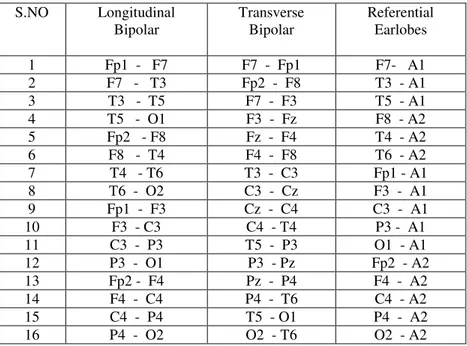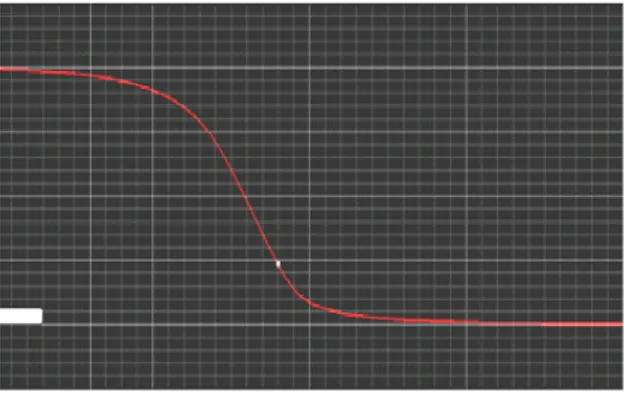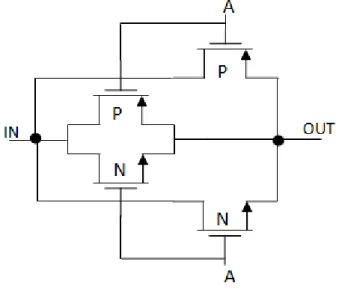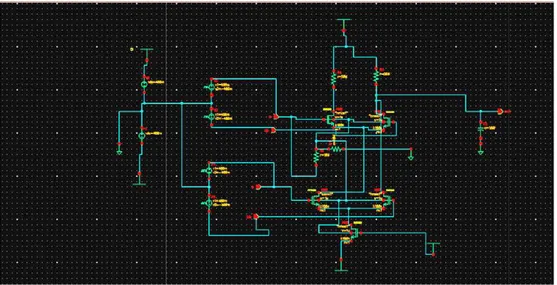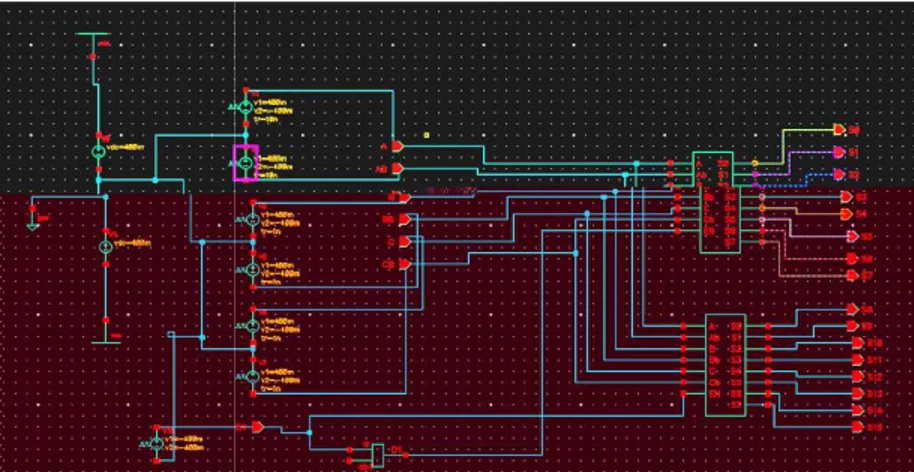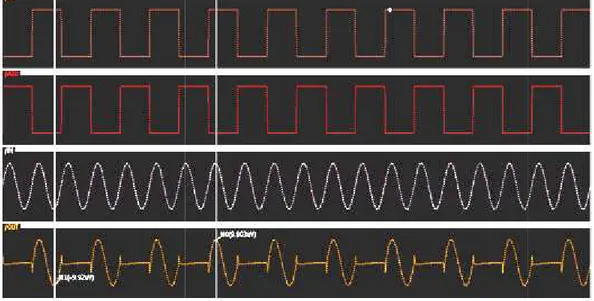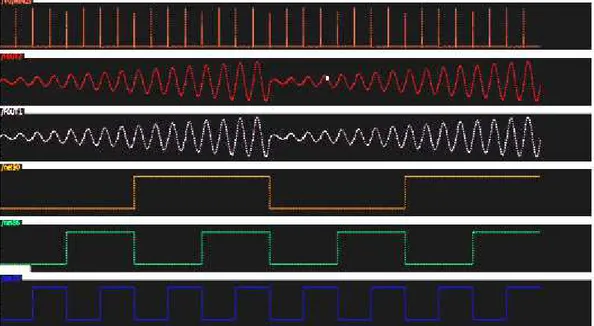International Journal of VLSI design & Communication Systems (VLSICS) Vol.6, No.1, February 2015
G. Deepika
1and Dr. K.S.Rao
21
Department of Electronics and Communication Engineering,
RRS College of Engineering & Technology, Hyderabad, India
2
Department of Electronics and Communication Engineering,
ANURAG Group of Institutions, Hyderabad, India
A
BSTRACTEEG signals are the signatures of neural activities and are captured by multiple-electrodes and the signals are recorded from pairs of electrodes. To acquire these multichannel signals a low power CMOS circuit was designed and implemented. The design operates in weak inversion region employing sub threshold source coupled logic. A 16 channel differential multiplexer is designed by utilizing a transmission gate with dynamic threshold logic and a 4 to 16 decoder is used to select the individual channels. The ON and OFF resistance of the transmission gate obtained is 27 ohms and 10 M ohms respectively. The power dissipation achieved is around 337nW for a dynamic range of 1µV to 0.4 V.
K
EYWORDSEEG, Subthreshold , Differential MUX, Low Power
1. I
NTRODUCTION
The billions of neurons present in the cerebral cortex and any number of them may be active at a particular moment of time produces brains electrical activity as seen the scalp EEG, which is a continuum of electrical discharges that may vary from moment to moment. This electrical activity is different in frequency and amplitude over different areas of brain. To obtain a complete and valid picture of the brains electrical activity, it is necessary to simultaneously record samples of activity from different areas of the scalp.
International Journal of VLSI design & Communication Systems (VLSICS) Vol.6, No.1, February 2015
The placement of electrodes in this system depends upon the measurements made from standard land marks on the skull. In general, the EEG signals are the projection of neural activities that are attenuated by the scalp. However, on the scalp the amplitudes commonly lie within 10–100 µV.
The International Federation of Societies for Electroencephalography and Clinical Neurophysiology has recommended the conventional electrode setting (also called 10–20) for 21 electrodes (excluding the earlobe electrodes) [17]. The recordings of EEG from various pairs of electrodes can be made as mentioned in the Table 1.
Table -1: Electrode combination for recording EEG S.NO Longitudinal
Bipolar
Transverse Bipolar
Referential Earlobes
1 Fp1 - F7 F7 - Fp1 F7- A1
2 F7 - T3 Fp2 - F8 T3 - A1
3 T3 - T5 F7 - F3 T5 - A1
4 T5 - O1 F3 - Fz F8 - A2
5 Fp2 - F8 Fz - F4 T4 - A2
6 F8 - T4 F4 - F8 T6 - A2
7 T4 - T6 T3 - C3 Fp1 - A1
8 T6 - O2 C3 - Cz F3 - A1
9 Fp1 - F3 Cz - C4 C3 - A1
10 F3 - C3 C4 - T4 P3 - A1
11 C3 - P3 T5 - P3 O1 - A1
12 P3 - O1 P3 - Pz Fp2 - A2
13 Fp2 - F4 Pz - P4 F4 - A2
14 F4 - C4 P4 - T6 C4 - A2
15 C4 - P4 T5 - O1 P4 - A2
16 P4 - O2 O2 - T6 O2 - A2
In Real time system design the major important task is the implementation of high performance signal processing and conditioning block. Many signal processing applications like from switching of weak signals to complex processing of audio and video signals requires an essential component and one such is Analog switch. The building blocks designed with these switches implemented in CMOS technology proved superior to its counter parts. Implementation of these blocks depends upon process variations and mismatching of various components and devices[1].
For low power applications, designing of these switches with reduced channel lengths creates new challenges. The recent advances through new techniques and technologies, provides several alternatives in implementation.
International Journal of VLSI desi
This work proposes a new techn threshold region for implementin and threshold voltages of the dev
In this work sub threshold (STS can be set as low as 10pA. A implementing the low power ana consumption and experimental re
2. S
UBTHRESHOLD
S
OU
In STSCL circuits the logic oper of operation is high. The tail cur switch will steered to one of th converted to output voltage by voltage swing should be adequa The input pair drain source over
Fig.1. Sour
The FIG 1 shows inverter / buff of NMOS source coupled switc 13]. Biasing PMOS device ope achieve desired logic function N tail bias current is steered into o converted into voltage by the PM
The DC response of the SCL circ
esign & Communication Systems (VLSICS) Vol.6, No.1, Fe
hnique utilizing source coupled logic (SCL) circuit b ting analog switch achieving low power consumption evice will not influence the speed of operation.
SCL) gates were implemented where the bias curren A brief introduction of SCL circuits, the proposed t nalog switch ( Transmission Gate) using sub STSCL l results are described in the following sections.
URCE
-C
OUPLED
L
OGIC
C
IRCUITS
peration mainly takes place in current domain and hen current Iss in an NMOS source coupled differential pa
the output that depends on the input logic. This cu y the load resistor RL to drive the other SCL gates
uately high in order to switch the input differential p er drive voltage should be larger than 2 n Vds sat whe
urce Coupled Logic-based inverter/buffer circuit.
ffer circuit based on source coupled logic. Using com itching pairs more complex logic functions can be imp perating in triode region can be used as load resistan NMOS switching network should be arranged in pro o one of the branch of the source coupled pair and t
MOS load devices.
ircuit is given in FIG 2.
February 2015
it biased in sub ion. The supply
ent of each cell d technique for L gates, power
ence the speed pair acting as a urrent will be tes. The output l pair (RL ISS ).
here Vin = 0.
mplex network plemented [7, ance RL and to
International Journal of VLSI desi
FI
The device operating in sub thr rather than on the device size parameters [12]. In SCL topolog capacitances and the voltage swi swing is equal to VDD. The vo high enough to switch the tail bi swing at the output node is given
V
SWThis should be high enough for s SCL circuit is adequately high i the output of the each SCL gat region of operation of NMOS de
V
SW min{ = 2 n V
D Sat{ = 4 n U
Tn, sub threshold slope factor o threshold region can be approxim of the threshold voltage of the N the tail bias current can be reduce input differential pair trans condu
G
m= I
OUT/ V
IN= (I
S3. T
RANSMISSION
G
ATE
PMOS and NMOS Transistors c switch which selectively allows turned ON or OFF by applying c
A CMOS transmission gate is sh course) so that the NMOS and
esign & Communication Systems (VLSICS) Vol.6, No.1, Fe
FIG 2. DC response of the SCL circuit.
hreshold region strongly depends on the temperature ze. Transfer curve cannot be changed by changin ogy the current required for charging and discharging wing is less in comparison to the CMOS topology wh voltage swing at the input and output of a logic circ bias current completely to one of the output branches
en as
= I
SSR
L--- (1)
r switching the next stage of the differential pair. If th it can be used as a logic circuit with allowable nois ate the minimum allowed voltage swing can be obt devices [17,18].
in strong inversion --- (2)
in sub threshold region
of the NMOS device. The required voltage swin ximately 150 mV at room temperature. This swing is NMOS devices. When SCL gate is biased in sub thre uced till the leakage currents in the circuit become com
ductance is given as
SS
/ 2nU
T) . ( cosh
2( V
IN/ 2nU
T)
-1--- (3)
TE
D
ESIGN
s can be combined as transmission gate for impleme ws or blocks the signal from input to output. The tr control signals to the gates in complimentary manner
shown in Figure 3. Included in the gate is an inverte and PMOS gates get complementary signals. When
February 2015
re through UT ing the design ng the parasitic here the signal rcuit should be es. The voltage
the gain of the oise margin. At btained by the
ing in the sub is independent reshold region, omparable. The
3)
menting analog transistors are er.
International Journal of VLSI design & Communication Systems (VLSICS) Vol.6, No.1, February 2015
voltage, VC is low, the NMOS gate gets a low voltage and is turned off. The PMOS gate gets a high voltage and is likewise turned off. When the control voltage is high, the gate is turned on with both transistors able to conduct. As discussed above, each cannot conduct all the way to both power supply rails, but they do so at either end so they complement each other and together they can conduct to the rails.
When the gate is off, the resistance of the gate is theoretically infinite. However, there is always some conduction so in reality, the resistance is finite. The off resistance is given in the specifications for the device and is typically in the megohms. When the gate is ON,however, we would like the resistance to be low. To examine this case, consider the circuit in Figure 4. Here we look at the case where the input voltage is VDD, and the gate is turned on with the output voltage starting at zero. We look at the resistance as the capacitor is charged and the output voltage rises to VDD.
The voltage across both devices is VDD - Vo, and the resistance of each is simply the voltage across it divided by the current through it, IDS for the NMOS of ISD for the PMOS.
R = ( V
dd- V
o) / I --- (4)
The total equivalent resistance is the parallel combination of the two.
FIG-3: Transmission Gate
International Journal of VLSI design & Communication Systems (VLSICS) Vol.6, No.1, February 2015
Fig: 4. Modified Transmission gate
The stacking of transistors improves the aspect ratio, performance and ON resistance. The transistor widths are maintained in the ratio 1:2 for NMOS to PMOS. The performance varies largely because of stacking as the variation almost doubles with two fingers than that of a single transistor.
4. D
YNAMIC
T
HRESHOLD
T
RANSMISSION
G
ATE
Body bias effect is normally studied in the reverse bias regime, where threshold voltage increases as body-to-source reverse bias is made larger. DTMOS operates in the exact opposite regime. Namely, the body-source junction is “forward biased” (at less than 0.6 V), forcing the threshold voltage to drop.
V
th= 2
B+ V
FB+
( 2 SqN
a(2
B)
1/2---
--- (5)
C
OXThe transistor threshold voltage Vt changes with the difference of voltage between Source and
bulk VSB. The bulk is treated as a second gate because VSB effects threshold voltage Vt which
helps in identifying the switching behavior of the transistor. The body effect is measured in terms of body coefficient γγγγ(gamma). The threshold voltage of the Transistor is given as
V
th= V
Th0+
B( |2
F+ V
SB|)
1/2- |2
F| )
1/2--- (6)
where φF is the bulk Fermi- potential ,VTh0 is the threshold voltage when VSB=0 and γB is the
body-effect coefficient. Therefore the threshold voltage can be varied by dynamically by varying VSB which forms DTMOS transistor. Typically, the source and body is either zero biased or
International Journal of VLSI desi
5. STSCL D
ECODER
D
E
The design of a Two Input AND constant at the output node of eac
T = R
L. C
L= V
And the time constant gets mult at the source of each NMOS d differential pairs. However th differential pairs.
F
esign & Communication Systems (VLSICS) Vol.6, No.1, Fe
FIG 5 : DTMOS Transmission Gate
ESIGN
:
D gate using the SCL topology is given in FIG 6 bel each SCL gate is
V
SW. C
L/ I
SS--- (7)
ultiplied with the number of stages. The parasitic cap differential pair will effect time constant of th the speed of operation will not be degraded by st
FIG 6: 2 input AND gate using SCL topology.
February 2015
elow. The time
International Journal of VLSI desi
The above circuit is modified int with fourth input as Enable and response is shown in FIG’s 7 and
Fig 7: combi
Fig
esign & Communication Systems (VLSICS) Vol.6, No.1, Fe
into a four input AND gate which is used to design a 3 nd the decoder operates when Enable is High. The ci
nd 8 respectively.
bination of 3 to 8 decoders to form 4 to 16 decoder
ig 8: Response of decoder when D input ( Enable) is HIGH
February 2015
3 to 8 decoder circuit and the
International Journal of VLSI design & Communication Systems (VLSICS) Vol.6, No.1, February 2015
6.
M
ULTIPLEXER
D
ESIGN
In the past the multiplexers are designed using the concept of shift registers which are built by synchronously triggered D flip flops with external clock. The major disadvantage of this circuit is the clock feed through to the output line and moreover glitches occur for every positive and negative clock edge. This problem has been reduced in the proposed multiplexer design.
In place of the static body bias used once either during design or at production the dynamic body bias can be utilized which changes many times and also reduces the temperature and aging effects. The DBB minimizes the temperature and aging effects and also for optimizing very low power operation the power management modes are utilized effectively [7, 8]
In FIG 4 the NMOS and PMOS transistors will turn ON by the SEL and the complimentary SELBR signal and the input signal will be allowed to pass to the output. Complimentarily both the transistors will turn OFF when SEL is at logic ‘0’ and the input signal will be blocked. During the transition period the output will be forced to high impedance state from ON to OFF and during this state small dc voltage will appear at the output due to charging of the junction capacitance. This is reduced by connecting a PMOS transistor between the output and ground which turns ON when all transistors are OFF forcing the output to ground.
The NMOS and PMOS transistor widths are maintained in the ratio of 1:2 and the ON resistance Ron of the transmission gate is given as
…….. (8)
The overdrive voltage, Vov = Vgs – Vth and the aspect ratio W/L decide the value of Ron. The ON
resistance of 27 ohms and OFF resistance of 10Mohms were obtained with very low leakage current in the order of Pico amperes. The response of a single channel transmission gate is given in Fig 9.
1 1
Ron = =
g
dsµC
oxW
(V
GS– V
Th)
International Journal of VLSI desi
Fig 9: R
A 16 channel analog multiplexer 4 for each channel. The channel AND gate shown in FIG 5. T multiplexer is given in Fig 10 be 1KHz is given in Fig 11 and the
Fig
esign & Communication Systems (VLSICS) Vol.6, No.1, Fe
Response of single channel Transmission gate
xer is designed using the modified transmission gate s nels are selected by a 4 to 16 decoder designed using . The complete circuit diagram of the 16 channe below and the response of the circuit for a switching
e power dissipation measured is 337 nW.
ig 10: 16 channel differential Multiplexer
February 2015
International Journal of VLSI design & Communication Systems (VLSICS) Vol.6, No.1, February 2015
Fig 11: Response of the 16 channel Multiplexer
7. R
ESULTS
AND
C
ONCLUSIONS
The Transmission gate is designed using PMOS and NMOS transistors in 180nm technology and the dynamic body bias is provided by means of a potential divider using poly resistors. The widths of the transistors are fixed as 15 and 30nm for N and PMOS respectively. The design is implemented in 180nm using Cadence Tools. The decoder is designed by AND gates using sub threshold source coupled logic. The output of the decoder drives the Transmission gates. The responses of the decoder Transmission gates and multiplexer and are shown in Fig’s 8, 9 &11 respectively. The total power dissipation is measured as 337nW upto a frequency of 4 KHz.
This circuit can be used to acquire EEG signals from 16 channels as mentioned in Table 1 consisting maximum frequency of 70Hz and are sampled at 250Hz. The circuit designed is simulated with a maximum switching frequency of 4 KHz to accommodate all 16 channels and the total power consumed is measured as 337nW. Since the maximum power consumed is by the decoding circuitry a different technique can be utilized to reduce this power consumption.
A
CKNOWLEDGEMENTSThe authors are highly indebted to the Chairman of ANURAG GROUP OF INSTITUTIONS Dr.P. Rajeshwar Reddy for his valuable support and providing all facilities to carry out this work.
International Journal of VLSI design & Communication Systems (VLSICS) Vol.6, No.1, February 2015
REFERENCES
[1] M. Horowitz et al., “Low-power digital design,” in Proc. IEEE Int.Symp. Low Power Electronics and Design (ISLPED), 1994, pp. 8–11.
[2] D. Suvakovic and C. A. T. Salama, “A low Vt CMOS implantation of an LPLV digital filter core for portable audio applications,” IEEE Trans. Circuits Syst. II, Analog Digit. Signal process., vol. 47, no. 11,pp. 1297–1300, Nov. 2000.
[3] G. Gielen, “Ultra-low-power sensor networks in nanometer CMOS,” in Int. Symp. Signals, Circuits and Systems (ISSCS), Jul. 2007, vol. 1,pp. 1–2.
[4] B. A.Warneke and K. S. J. Pister, “An ultra-low energy microcontroller for smart dust wireless sensor networks,” in IEEE Int. Solid-State Circuits Conf. (ISSCC) Dig. Tech. Papers, 2004, pp. 316–317. [5] L. S. Wong et al., “A very low-power CMOS mixed-signal IC for implantable pacemaker
applications,” IEEE J. Solid-State Circuits, vol.39, no. 12, pp. 2446–2456, Dec. 2004.
[6] C. Enz and E. Vittoz, Charge-Based MOS Transistor Modeling: TheEKV Model for Low-Power and RF IC Design. New York: Wiley,2006.
[7] C. Enz, F. Krummenacher, and E. Vittoz, “An analytical MOS transistor model valid in all regions of operation and dedicated to lowvoltage and low-current applications,” Analog Integr. Circuits Signal Process. J., vol. 8, pp. 83–114, Jun. 1995.
[8] C. Enz, M. Punzenberger, and D. Python, “Low-voltage log-domain signal processing in CMOS and BiCMOS,” IEEE Trans. Circuits Syst. II, Analog Digit. Signal Process., vol. 46, no. 3, pp. 279–289, Mar.1999.
[9] B. H. Calhoun, A. Wang, and A. Chandrakasan, “Modeling and sizing for minimum energy operation in subthreshold circuits,” IEEE J. Solid-State Circuits, vol. 40, no. 9, pp. 1778–1786, Sep. 2005. [10] B. H. Calhoun and A. Chandrakasan, “Ultra-dynamic voltage scaling (UDVS) using subthreshold
operation and local voltage dithering,”IEEE J. Solid-State Circuits, vol. 41, no. 1, pp. 238–245, Jan. 2006.
[11] R. Amirtharajah and A. Chandrakasan, “A micropower programmable DSP using approximate signal processing based on distributed arithmetic,”IEEE J. Solid-State Circuits, vol. 39, no. 2, pp. 337–347, Feb.2004.
[12] H. Soeleman, K. Roy, and B. C. Paul, “Robust subthreshold logic for ultra-low-power operation,” IEEE Trans. Very Large Scale Integr.(VLSI) Syst., vol. 9, no. 1, pp. 90–99, Sep. 2001.
[13] A. Chandrakasan and R. Brodersen, “Minimizing power consumption in digital CMOS circuits,” Proc. IEEE, vol. 83, no. 4, pp. 498–523,Apr. 1995.
[14] A. Chandrakasan and R. Brodersen, “Minimizing power consumption in digital CMOS circuits,” Proc. IEEE, vol. 83, no. 4, pp. 498–523,Apr. 1995.
[15] Hari Priya, Dr.K.S.Rao et al “Design of ultra low power 8-channel analog multiplexer using dynamic threshold for biosignals” International Journal of VLSI design & Communication Systems (VLSICS) Vol.4, No.5, October 2013.
[16] Hari Priya, Dr.K.S.Rao et al “A low power front end analog multiplexing unit for 12 lead ecg signal acquisition” International Journal of VLSI design & Communication Systems (VLSICS) Vol.5, No.3, June 2014.
[17] P.R.Gray, P. J.Hurst, S.H. Lewis, and R.G.Meyer, Analysis and Design of Analog Integrated Circuits, Wiely, Fourth Ed., 2000
International Journal of VLSI design & Communication Systems (VLSICS) Vol.6, No.1, February 2015
AUTHORS
G. Deepika obtained her B.E., M.Tech degree in ECE in the year of 2002, 2005 from CBIT, Osmania University and JNT University, Hyderabad respectively. She had 10 years of teaching experience. Presently she is an Associate Professor in RRS College of Engineering & Technology, Medak District and pursuing Ph.D in JNT University,Hyderabad.
Dr. K. S. Rao obtained his B. Tech, M. Tech and Ph.D. in Electronics and Instrumentation Engineering in the years 1986, 89 and 97 from KITS, REC Warangal and VRCE Nagpur respectively. He had 25 years of teaching and research experience and worked in all academic positions, presently he is the Director, Anurag Group of Institutions (Autonomous) Hyderabad. His fields of interests are Signal Processing, Neural Networks and VLSI system design.
